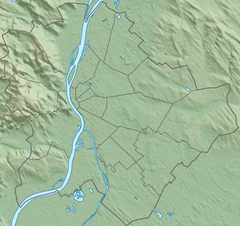Széchenyi Medicinal Bath
| Széchenyi Thermal Bath | |
|---|---|
 |
|
| Location | City Park, Budapest, Hungary |
| Coordinates | 47°31′07″N 19°04′55″E / 47.51861°N 19.08194°ECoordinates: 47°31′07″N 19°04′55″E / 47.51861°N 19.08194°E |
| Built | 1913 |
| Architect | Győző Czigler |
The Széchenyi Medicinal Bath in Budapest (IPA: [seːtʃeːɲi], Hungarian: Széchenyi-gyógyfürdő) is the largest medicinal bath in Europe. Its water is supplied by two thermal springs, their temperature is 74 °C (165 °F) and 77 °C (171 °F), respectively.
Components of the thermal water include sulphate, calcium, magnesium, bicarbonate and a significant amount of fluoride acid and metaboric acid. Medical indications are on degenerative joint illnesses, chronic and sub-acute joint inflammations, as well as orthopaedic and traumatological post-treatments.
In planning since the 1880s, the bath had originally been referred to as the Artesian spa (Artézi fürdő), but when it opened on 16 June 1913, it was officially named Széchenyi spa (Széchenyi gyógyfürdő) after István Széchenyi.
The bath, located in the City Park, was built in Neo-baroque style to the design of Győző Czigler. Construction began on 7 May 1909 with designs by architect Eugene Schmitterer. The pool construction cost approximately 3.9 million Austro-Hungarian korona. The built-up area was 6,220 square metres (67,000 sq ft). The attendance of spa was in excess of 200,000 people in 1913. This number increased to 890,507 by 1919. At that time it had private baths, separate men and women steam-bath sections, and different men / women "public baths". The complex was expanded in 1927 to its current size, with 3 outdoor and 15 indoor pools. It is now possible for both sexes to visit the main swimming and thermal sections.
After the expansion, the thermal artesian well could not supply the larger volume of water needed, so a new well was drilled. The second thermal spring was found in 1938 at a depth of 1,256 metres (4,121 ft), with a temperature of 77 °C (171 °F). It supplies 6,000,000 litres (1,600,000 US gal) of hot water daily. Between 1999 and 2009 the full reformation of the Széchenyi thermal bath took place within the confines of a blanket reconstruction.
...
Wikipedia

